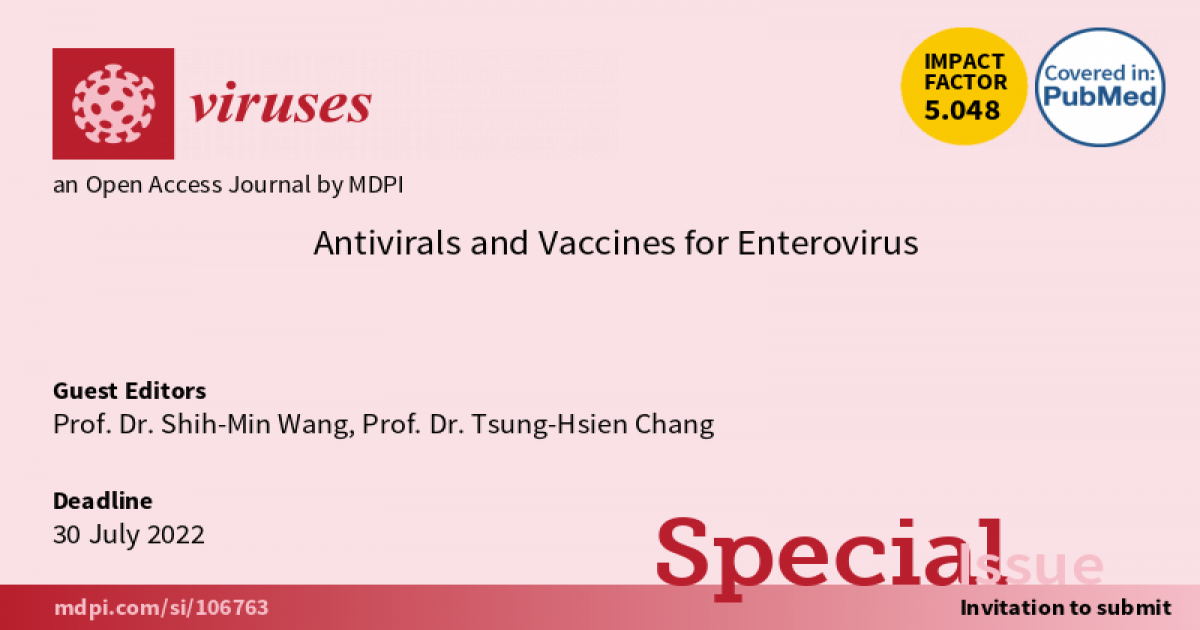Antivirals and Vaccines for Enterovirus
A special issue of Viruses (ISSN 1999-4915). This special issue belongs to the section "Viral Immunology, Vaccines, and Antivirals".
Deadline for manuscript submissions: closed (30 July 2022) | Viewed by 6668

Special Issue Editors
Interests: enteroviruses infection; antiviral responses; vaccine immunity
Special Issue Information
Dear Colleagues,
Enteroviruses belong to the genus Enterovirus and family Picornaviridae, including polioviruses, Coxsackie A viruses, Coxsackie B viruses, echoviruses, and other numbered enteroviruses. Enteroviruses are one of the most common viruses infecting children, causing mild diseases such as hand, foot, and mouth disease (HFMD) and herpangina. However, potentially life-threatening complications such as meningoencephalitis, myocarditis, hepatitis, and disseminated intravascular coagulation are of the greatest clinical and public concern. Currently, drug development through various approaches has revealed potential anti-enteroviruses candidates. In addition, some of the available or in-development enterovirus vaccines in certain regions have been brought to light ways to prevent enterovirus disease.
This Special Issue welcomes all types of manuscripts (e.g., reviews, research articles, and short communications) that highlight and advance current understandings of antivirals and vaccines in this significant field. This is a great opportunity to shed light on new strategies for treating and preventing enterovirus infections.
Prof. Dr. Shih-Min Wang
Prof. Dr. Tsung-Hsien Chang
Guest Editors
Manuscript Submission Information
Manuscripts should be submitted online at www.mdpi.com by registering and logging in to this website. Once you are registered, click here to go to the submission form. Manuscripts can be submitted until the deadline. All submissions that pass pre-check are peer-reviewed. Accepted papers will be published continuously in the journal (as soon as accepted) and will be listed together on the special issue website. Research articles, review articles as well as short communications are invited. For planned papers, a title and short abstract (about 250 words) can be sent to the Editorial Office for assessment.
Submitted manuscripts should not have been published previously, nor be under consideration for publication elsewhere (except conference proceedings papers). All manuscripts are thoroughly refereed through a single-blind peer-review process. A guide for authors and other relevant information for submission of manuscripts is available on the Instructions for Authors page. Viruses is an international peer-reviewed open access monthly journal published by MDPI.
Please visit the Instructions for Authors page before submitting a manuscript. The Article Processing Charge (APC) for publication in this open access journal is 2600 CHF (Swiss Francs). Submitted papers should be well formatted and use good English. Authors may use MDPI's English editing service prior to publication or during author revisions.
Keywords
- enterovirus
- picornaviruses
- antivirals
- drug development
- vaccines
Benefits of Publishing in a Special Issue
- Ease of navigation: Grouping papers by topic helps scholars navigate broad scope journals more efficiently.
- Greater discoverability: Special Issues support the reach and impact of scientific research. Articles in Special Issues are more discoverable and cited more frequently.
- Expansion of research network: Special Issues facilitate connections among authors, fostering scientific collaborations.
- External promotion: Articles in Special Issues are often promoted through the journal's social media, increasing their visibility.
- Reprint: MDPI Books provides the opportunity to republish successful Special Issues in book format, both online and in print.
Further information on MDPI's Special Issue policies can be found here.







